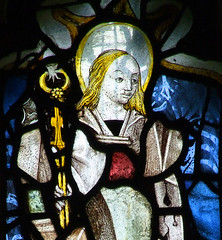| |
|
 |
|
This little
church has seen great changes in
its lifetime, perhaps none so
dramatic as those of the last few
decades. It sits across the
fields from the beautiful,
secluded red brick of Chilton
Hall, a footpath to it running
through woods and between fields
for about a quarter of a mile. My wife
remembers blackberrying here as a
child some thirty-odd summers
ago. She took her shoes off to
wander barefoot in the hot dust;
as she leant across a ditch to
reach the fruit, a rat broke
cover and ran across her feet. The church
is similarly built largely of red
brick with a flint nave, a
pleasing contrast with the green
of the trees and hedgerows. But
the birdsong that was once all
you'd have heard has been
replaced by the roar of traffic
on the Sudbury bypass a few
hundred yards to the west, and a
great commercial and industrial
estate has reached and embraced
St Mary, so it is no longer
lonely and isolated. Be that as
it may, the walk from Chilton
Hall through the woods and fields
is still possible today, although
the expansion of Sudbury may make
the building of houses here
increasingly likely.
The
irony is that the church's former
loneliness was very nearly its
demise, for the tiny parish could
no longer support its church by
the late 1970s, and it was drawn
into the parish of Sudbury St
Gregory, with St Mary being
declared redundant and left to
its fate. Fortunately however,
this little church has some very
energetic and enthusiastic
friends who rolled up their
sleeves and take good care of it,
and in the 1980s it was vested in
the care of the Churches
Conservation Trust, who are now
its custodians.
|
|
The
churchyard is a a narrow oasis, making the church
appear larger than it actually is, and the two
most striking features of the building are the
tower and the large chapel on the north side of
the chancel. The splendid red brick tower, one of
the loveliest in Suffolk, was built on the eve of
the Reformation. It has more in common with the
red brick towers just over the border in Essex at
Gestingthorpe and Wickham St Paul. The Victorians
topped it with battlements and turrets, and it is
a fine sight through the industrial units from
the west. Contemporary with it is the large
chantry chapel to the Crane family to the north
of the chancel, but the body of the church isn't
much older, being good Suffolk Perpendicular.
What we have, then, is a building that was
constructed pretty much in its entirety during
the lifetimes of some of its parishioners.
You
can collect the key from a cottage beyond the
Hall, and you let yourself into the Crane chantry
chapel. This is a large open space, not much
smaller than the nave of the church to the
south-west of it. The earliest of the Cranes lie
up one corner, beside the chancel. George Crane
died in 1491, and looks rather lonely here,
seeing out the centuries in alabaster. But there
is a beautifully serene expression on his face,
and it is hard to think that it was not intended.
Above him to the south are his parents Robert and
Anne Crane, also in alabaster of 1500. He is in
armour without a helmet, she wears the collar of
Ss. The little unicorn under his feet has mislaid
his horn, and only the socket remains to tell us
what he is. Mortlock notes that Robert and Anne
appear among the donors in stained glass a few
miles off at Long Melford. Cranes of a century or
so later are on the west wall of the chapel, full
of self-importance and with nothing like the
humanity of their ancestors.
In the presence of these
grand figures, it would be possible to
miss what is probably the greatest
treasure of the church. In the east
window of the chapel are two relatively
complete figures in 15th Century stained
glass, of St Apollonia holding her tooth
in pincers and St Michael dispatching the
devil. They are exquisite.
You step through into the
nave, which is simply furnished and full
of light. There is no stained glass here.
The low dado remains of the screen, and
the little chancel cannot help but seem a
little cluttered. Without the Crane
chapel, this church would be by no means
as significant. But it would still be
very lovely. There is such a sense of
love here, everything well-kept and
well-cared for, everything in its right
place.
Outside, in the churchyard,
a small number of gravestones remain, and
they're worth exploring. One that
particularly caught my eye was to a child
called Sparrow Brand Steed, the curious
name perhaps a result of non-conformist
parents deliberately giving a
non-Christian first name. Beside it, a
woman weeps on the urn of Thomas Creaton,
a former servant at the Hall.
|
|
 |
|
|
|

